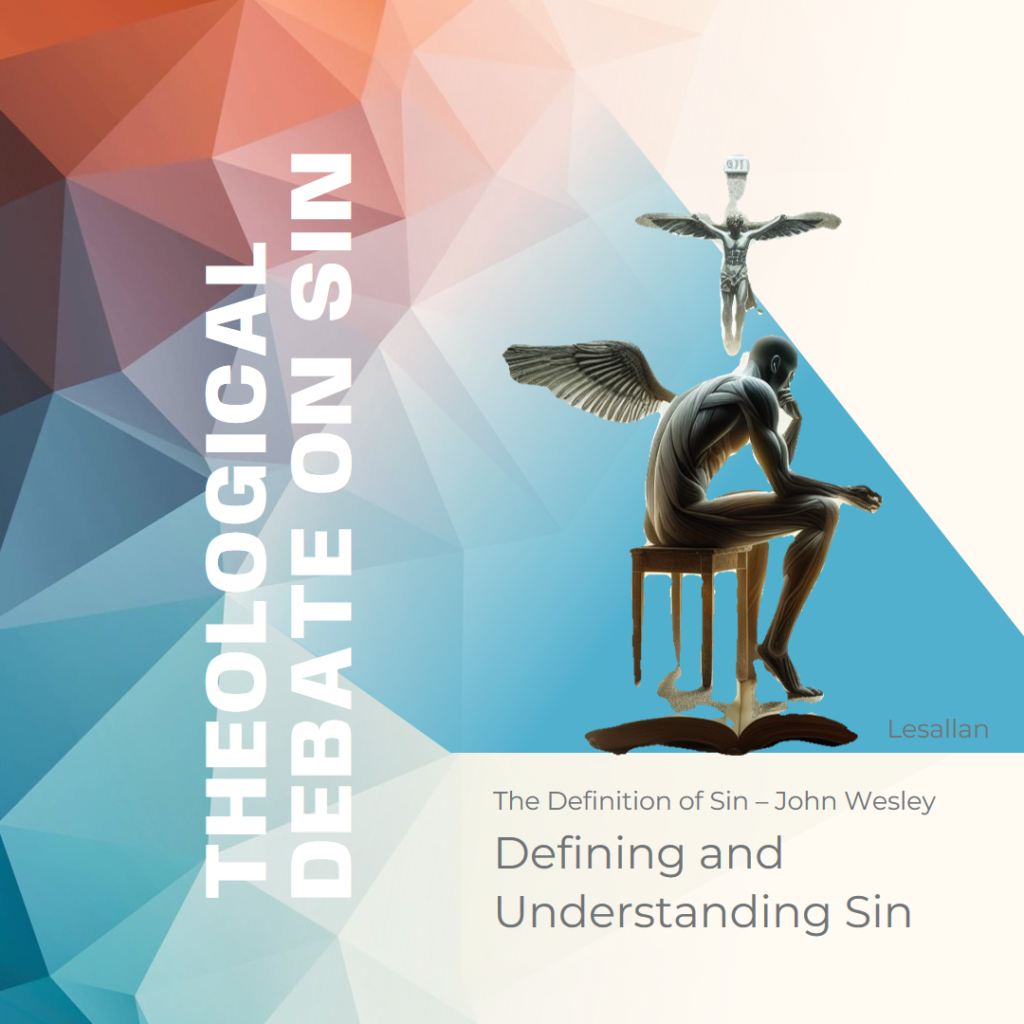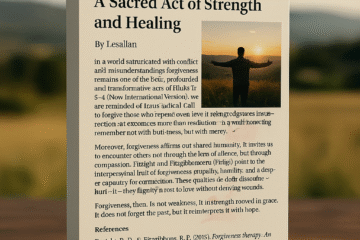The Definition of Sin – John Wesley
Written by Lesallan
Ohio Christian University
THE3360 Theology of John Wesley (ONLSP24)
Dr. Steven Gerig
January 27, 2024

The Definition of Sin – John Wesley
The concept of sin, its definition, and its implications have been subjects of theological debate for centuries. One influential figure in this discourse is John Wesley, a theologian whose views on sin have shaped Christian thought and practice. Wesley’s definition of sin as a “willful violation of a known law of God” underscores the deliberate nature of sin, yet it may not fully encompass the attitudes and dispositions of the heart. This paper delves into Wesley’s doctrine of sin, its categories, and its centrality to his theology, particularly his understanding of Christian holiness.
John Wesley’s definition of sin as a “willful violation of a known law of God” highlights the intentional aspect of sin, but it may not fully address the attitudes and dispositions of the heart (Wesley, 1872). Wesley divided sin into two main categories: guilt and power, further dividing sin’s power into four sub-categories: habit, willful, desire, and infirmity. The cornerstone of his theology was his doctrine of sin, which he believed was intricately linked to his interpretation of Christian holiness.
Collins (1999) asserts that his personal encounters and biblical readings shaped Wesley’s comprehension of sin. Wesley believed that sin was a universal problem that affected all people and was the root cause of human suffering. He also believed that sin was a voluntary act that required a conscious decision to violate God’s law. Wesley’s emphasis on the intentional aspect of sin was a response to the antinomianism of his day, which downplayed the importance of obedience to God’s law.
Salter’s book (2020) provides a historical, theological, Biblical, and cultural exploration of the American Holiness Movement, closely tied to Wesley’s doctrine of sin. The book highlights the decline of the Holiness Movement in the United States and its impact on American Christianity. Salter argues that the Holiness Movement responded to American society’s perceived moral decline and emphasized the importance of personal holiness and sanctification. Living holy lives was imperative for Christians as per Wesley’s doctrine of sin, and the movement was intricately linked to this teaching. John Wesley’s definition of sin as a “willful violation of a known law of God” emphasizes the intentional aspect of sin, but it may not fully address the attitudes and dispositions of the heart. Wesley divided sin into two main categories: guilt and power, further dividing sin’s power into four sub-categories: habit, willful, desire, and infirmity. His doctrine of sin was central to his theology and was closely tied to his understanding of Christian holiness. Collins’ book provides a detailed account of Wesley’s life and theology, while Salter’s book explores the historical, theological, Biblical, and cultural context of the American Holiness Movement and its relationship to Wesley’s doctrine of sin.
John Wesley’s relationships with women were complex and often fraught with tension and conflict. Wesley married Mary Vazeille in 1751, but their marriage was troubled. Wesley was often away due to his preaching duties, and Mary left at home and grew suspicious of his frequent correspondence with other women. According to Collins (1999), Wesley thought highly of women and encouraged them to share the gospel equally. Wesley’s views on women were progressive for his time, and he objected to men describing women as “agreeable playthings” to be seen and not heard (Wesley, 1872).
Wesley’s relationship with Sally Kirkham, a woman he met in 1725, was also complicated. Wesley was fond of Sally, and their relationship was flirtatious, but it never progressed beyond that. Sally played a significant role in Wesley’s spiritual development, and their discussions on literature, theology, and spirituality were instrumental in Wesley’s pursuit of holiness. However, Sally married John Chapone in 1725, and Wesley continued to correspond with her even after marriage. Wesley’s mother, Susanna, was troubled by the ongoing correspondence between him and Sally. She was apprehensive that either Sally or her son might soon be swayed by thoughts and actions that were not virtuous (Collins, 1999).
According to Salter (2020), Wesley’s views on women were closely tied to his doctrine of sin and his emphasis on the need for Christians to live holy lives. Wesley believed that sin was a universal problem that affected all people and was the root cause of human suffering. He also believed that sin was a voluntary act that required a conscious decision to violate God’s law. Wesley’s emphasis on the intentional aspect of sin was a response to the antinomianism of his day, which downplayed the importance of obedience to God’s law. Wesley’s views on sin and holiness were central to his theology and were closely tied to his understanding of Christian living. John Wesley’s relationships with women were complex and often fraught with tension and conflict. Wesley’s marriage to Mary Vazeille was troubled initially, and his relationship with Sally Kirkham was complicated. Despite these personal struggles, Wesley thought highly of women and encouraged them to share the gospel equally. Wesley’s views on women were progressive for his time, and he objected to men describing women as “agreeable playthings” to be seen and not heard (Wesley, 1872). Wesley’s views on women were closely tied to his doctrine of sin and his emphasis on the need for Christians to live holy lives. Collins’ book provides a detailed account of Wesley’s life and theology, while Salter’s book explores the historical, theological, Biblical, and cultural context of the American Holiness Movement and its relationship to Wesley’s doctrine of sin.
John Wesley’s definition of sin, emphasizing willful transgression, reflects his deep commitment to personal holiness (Wesley, 1872). However, this definition may have contributed to difficulties in his personal life, particularly in his marriage. His relationships with women were marked by tension and misunderstanding, reflecting a struggle to balance his intense spiritual commitments with his relationships. Despite these challenges, Wesley’s theological contributions have profoundly impacted Christian thought.
Wesley’s views on sin and holiness were central to his theology and were closely tied to his understanding of Christian living. His doctrine of sin was central to his theology and was closely tied to his understanding of Christian holiness. Wesley believed sin was a voluntary act requiring a conscious decision to violate God’s law (Wesley, 1872). Wesley’s emphasis on the intentional aspect of sin was a response to the antinomianism of his day, which downplayed the importance of obedience to God’s law.
Salter’s book (2020) provides a historical, theological, Biblical, and cultural exploration of the American Holiness Movement, closely tied to Wesley’s doctrine of sin. The book highlights the decline of the Holiness Movement in the United States and its impact on American Christianity (Salter, 2020). Salter argues that the Holiness Movement responded to American society’s perceived moral decline and emphasized the importance of personal holiness and sanctification. The movement was closely tied to Wesley’s doctrine of sin and his emphasis on the need for Christians to live holy lives.
In summary, John Wesley’s definition of sin, emphasizing willful transgression, reflects his deep commitment to personal holiness (Wesley, 1872). However, this definition may have contributed to difficulties in his personal life, particularly in his marriage. His relationships with women were marked by tension and misunderstanding, reflecting a struggle to balance his intense spiritual commitments with his relationships. Despite these challenges, Wesley’s theological contributions have profoundly impacted Christian thought. Wesley’s views on sin and holiness were central to his theology and were closely tied to his understanding of Christian living (Collins, 1999). Salter’s book provides a historical, theological, Biblical, and cultural exploration of the American Holiness Movement, closely tied to Wesley’s doctrine of sin (Salter, 2020).
John Wesley’s doctrine of sin provides a comprehensive framework for understanding the nature of sin and its impact on human life. His emphasis on the willful violation of God’s law and the need for Christians to live holy lives has profoundly influenced Christian theology and practice (Wesley, 1872). However, his views also invite further exploration and discussion, particularly concerning the attitudes and dispositions of the heart. As we continue to grapple with sin in our contemporary context, Wesley’s insights serve as a valuable guide, reminding us of the universal problem of sin and the pursuit of holiness in the Christian life (Collins, 1999).
Indeed, examining John Wesley’s theological conclusions provides valuable insights into his understanding of sin and holiness. His views, shaped by personal experiences and biblical interpretations, offer a unique perspective on the nature of sin and the pursuit of Christian holiness. As we delve deeper into his theology, we better understand his doctrines and their implications for Christian thought and practice. This examination enriches our knowledge of Wesley’s theology and prompts us to reflect on our understanding of these concepts (Salter, 2020).
References:
Collins, K. J. (1999). A Real Christian: The Life of John Wesley. Abingdon Press.
Salter, D. (2020). The demise of the American Holiness Movement: a historical, theological, Biblical, and cultural exploration. First Fruits Press.
Wesley, J. (1872). The works of John Wesley (Vol. 6). Wesleyan Conference Office. (Original work published 1756).


